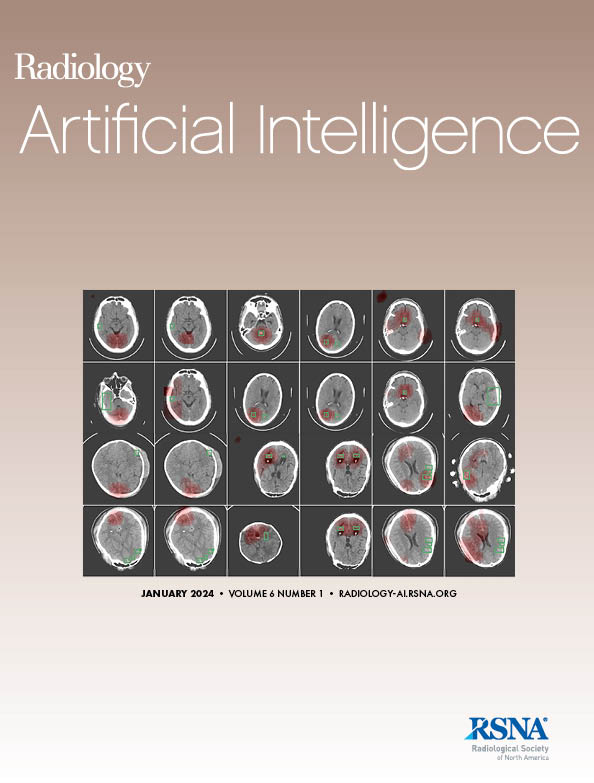下载PDF
{"title":"Deep Learning with Domain Randomization in Image and Feature Spaces for Abdominal Multiorgan Segmentation on CT and MRI Scans.","authors":"Yu Shi, Lixia Wang, Touseef Ahmad Qureshi, Zengtian Deng, Yibin Xie, Debiao Li","doi":"10.1148/ryai.240586","DOIUrl":null,"url":null,"abstract":"<p><p>Purpose To develop a deep learning segmentation model that can segment abdominal organs on CT and MRI scans with high accuracy and generalization ability. Materials and Methods In this study, an extended nnU-Net model was trained for abdominal organ segmentation. A domain randomization method in both the image and feature space was developed to improve the generalization ability under cross-site and cross-modality settings on public prostate MRI and abdominal CT and MRI datasets. The prostate MRI dataset contains data from multiple health care institutions, with domain shifts. The abdominal CT and MRI dataset is structured for cross-modality evaluation: training on one modality (eg, MRI) and testing on the other (eg, CT). This domain randomization method was then used to train a segmentation model with enhanced generalization ability on the abdominal multiorgan segmentation challenge dataset to improve abdominal CT and MR multiorgan segmentation, and the model was compared with two commonly used segmentation algorithms (TotalSegmentator and MRSegmentator). Model performance was evaluated using the Dice similarity coefficient (DSC). Results The proposed domain randomization method showed improved generalization ability on the cross-site and cross-modality datasets compared with the state-of-the-art methods. The segmentation model using this method outperformed two other publicly available segmentation models on data from unseen test domains (mean DSC, 0.88 vs 0.79 [<i>P</i> < .001] and 0.88 vs 0.76 [<i>P</i> < .001]). Conclusion The combination of image and feature domain randomizations improved the accuracy and generalization ability of deep learning-based abdominal segmentation on CT and MR images. <b>Keywords:</b> Segmentation, CT, MR Imaging, Neural Networks, MRI, Domain Randomization <i>Supplemental material is available for this article.</i> © RSNA, 2025 See also commentary by Mayfield in this issue.</p>","PeriodicalId":29787,"journal":{"name":"Radiology-Artificial Intelligence","volume":" ","pages":"e240586"},"PeriodicalIF":13.2000,"publicationDate":"2025-07-01","publicationTypes":"Journal Article","fieldsOfStudy":null,"isOpenAccess":false,"openAccessPdf":"https://www.ncbi.nlm.nih.gov/pmc/articles/PMC12476582/pdf/","citationCount":"0","resultStr":null,"platform":"Semanticscholar","paperid":null,"PeriodicalName":"Radiology-Artificial Intelligence","FirstCategoryId":"1085","ListUrlMain":"https://doi.org/10.1148/ryai.240586","RegionNum":0,"RegionCategory":null,"ArticlePicture":[],"TitleCN":null,"AbstractTextCN":null,"PMCID":null,"EPubDate":"","PubModel":"","JCR":"Q1","JCRName":"COMPUTER SCIENCE, ARTIFICIAL INTELLIGENCE","Score":null,"Total":0}
引用次数: 0
引用
批量引用
Abstract
Purpose To develop a deep learning segmentation model that can segment abdominal organs on CT and MRI scans with high accuracy and generalization ability. Materials and Methods In this study, an extended nnU-Net model was trained for abdominal organ segmentation. A domain randomization method in both the image and feature space was developed to improve the generalization ability under cross-site and cross-modality settings on public prostate MRI and abdominal CT and MRI datasets. The prostate MRI dataset contains data from multiple health care institutions, with domain shifts. The abdominal CT and MRI dataset is structured for cross-modality evaluation: training on one modality (eg, MRI) and testing on the other (eg, CT). This domain randomization method was then used to train a segmentation model with enhanced generalization ability on the abdominal multiorgan segmentation challenge dataset to improve abdominal CT and MR multiorgan segmentation, and the model was compared with two commonly used segmentation algorithms (TotalSegmentator and MRSegmentator). Model performance was evaluated using the Dice similarity coefficient (DSC). Results The proposed domain randomization method showed improved generalization ability on the cross-site and cross-modality datasets compared with the state-of-the-art methods. The segmentation model using this method outperformed two other publicly available segmentation models on data from unseen test domains (mean DSC, 0.88 vs 0.79 [P < .001] and 0.88 vs 0.76 [P < .001]). Conclusion The combination of image and feature domain randomizations improved the accuracy and generalization ability of deep learning-based abdominal segmentation on CT and MR images. Keywords: Segmentation, CT, MR Imaging, Neural Networks, MRI, Domain Randomization Supplemental material is available for this article. © RSNA, 2025 See also commentary by Mayfield in this issue.
基于图像和特征空间随机化的深度学习用于腹部CT和MRI多器官分割。
“刚刚接受”的论文经过了全面的同行评审,并已被接受发表在《放射学:人工智能》杂志上。这篇文章将经过编辑,布局和校样审查,然后在其最终版本出版。请注意,在最终编辑文章的制作过程中,可能会发现可能影响内容的错误。目的建立一种具有较高准确率和泛化能力的腹部器官CT和MR图像深度学习分割模型。在本研究中,我们训练了一个扩展的nnU-Net模型用于腹部器官分割。提出了一种图像和特征空间的域随机化方法,以提高前列腺MRI、腹部CT和MRI数据集在跨位点和跨模态设置下的泛化能力。前列腺MRI数据集包含来自多个医疗保健机构的数据,具有域移位。腹部CT和MRI数据集的结构用于跨模态评估,在一种模态(例如MRI)上进行训练,在另一种模态(例如CT)上进行测试。然后利用该领域随机化方法在腹部多器官分割挑战(AMOS)数据集上训练具有增强泛化能力的分割模型来改进腹部CT和MR多器官分割,并将该模型与两种常用的分割算法(TotalSegmentator和MRSegmentator)进行比较。采用Dice相似系数(DSC)对模型性能进行评价。结果与现有方法相比,所提出的领域随机化方法在跨站点和跨模态数据集上的泛化能力有所提高。使用该方法的分割模型在未见测试域的数据上优于其他两种公开可用的分割模型(平均DSC: 0.88 vs 0.79;P < 0.001和0.88比0.76;P < 0.001)。结论图像随机化与特征域随机化相结合,提高了基于深度学习的CT和MR图像腹部分割的准确率和泛化能力。©rsna, 2025。
本文章由计算机程序翻译,如有差异,请以英文原文为准。

 求助内容:
求助内容: 应助结果提醒方式:
应助结果提醒方式:


